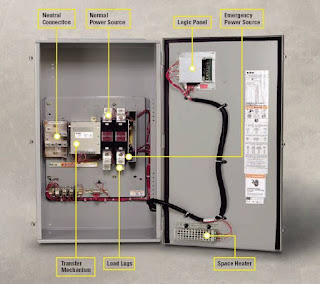Lightning arrester - Defination,working and types.
LIGHTNING ARRESTER
Defination: The device which is used for the protection of the equipment at the substations against travelling waves, such type of device is called lightning arrester or surge diverter. In other words, lightning arrester diverts the abnormals high voltage to the ground without affecting the continuity of supply. It is connected between the line and earth, i.e., in parallel with the equipment to be protected at the substation.
The following are the damages that are caused by the travelling wave on the substation equipment.
- The high peak or crest voltage of the surge may cause flash-over in the internal winding thereby spoil the winding insulation.
- The steep wave fronts of the surges may cause external flashover between the terminal of the transformer.
- The highest peak voltage of the surge may cause external flashover, between the terminal of the electrical equipment which may result in damage to the insulator.
WORKING PRINCIPLE:
Lightning arrestor working principle is, once the voltage surge travels throughout the conductor then it reaches the location of the arrestor where it is installed. So it will break down the insulation of the lightning arrestor for a moment, so voltage surge can be discharged toward the ground. Once the voltage of the system falls under the fixed value, then the insulation will be restored among the ground & conductor. Further, the current flow toward the ground will be stopped.
Types of Lightning Arrester:
Generally, lightning arresters are classified into different types. The construction of lightning arrestors is different based on its type but the working principle is the same. It provides a low resistance pathway to the surges in the direction of the ground. The types are:
- Horn gap arrester
- Multi gap arrester
- Valve type arrester
- Pellet type arrester
Location of Lightning Arrester:
The lightning arrester is located close to the equipment that is to be protected. They are usually connected between phase and ground in an AC system and pole and ground in case of the DC system. In an AC system, separate arrester is provided for each phase.
In an extra-high voltage AC system the surge diverter is used to protect the generators, transformers, bus bars, lines, circuit breakers, etc. In HVDC system the arrester is used to protect the buses, valves converter units reactors, filter, etc.
Difference between Lighting arrester and surge Arrester.
| Lightning arrester | Surge arrester |
| The installation of a lightning arrestor can be done outside of the panel board. | The installation of surge arrestors can be done within the panel board. |
| The main function of this arrester is to protect the apparatus from the outer surface. | The main function of this arrester is to protect the apparatus from inside |
| This arrester is mostly used for lightning strikes as well as linked surges. | This arrester defends the system from switching, lightning, surges, transients voltage & electrical faults. |
| This kind of arrester redirects the flow of current to the ground throughout the arrester device to the ground. | This kind of arrester interrupts the surges transmits surplus energy toward the ground wire. |
| The types of lightning arresters are rod, sphere, horn, multi gap, electrolyte, and metal oxide. | The types of surge arrestors are distribution, low-voltage, station, DC, neutral protection, fiber tube, signal, network, etc. |
Related post:Surge arrester-complete details




Comments
Post a Comment